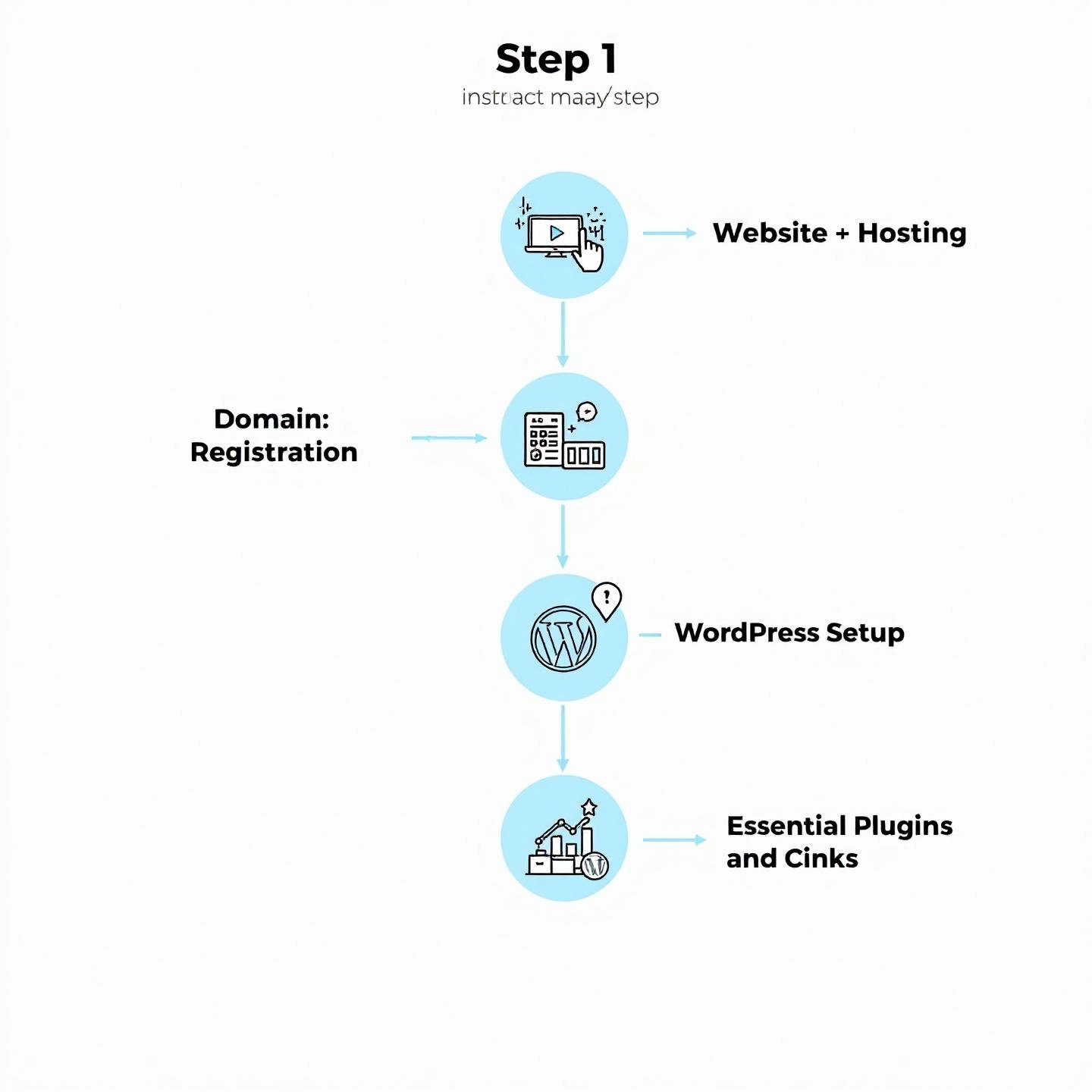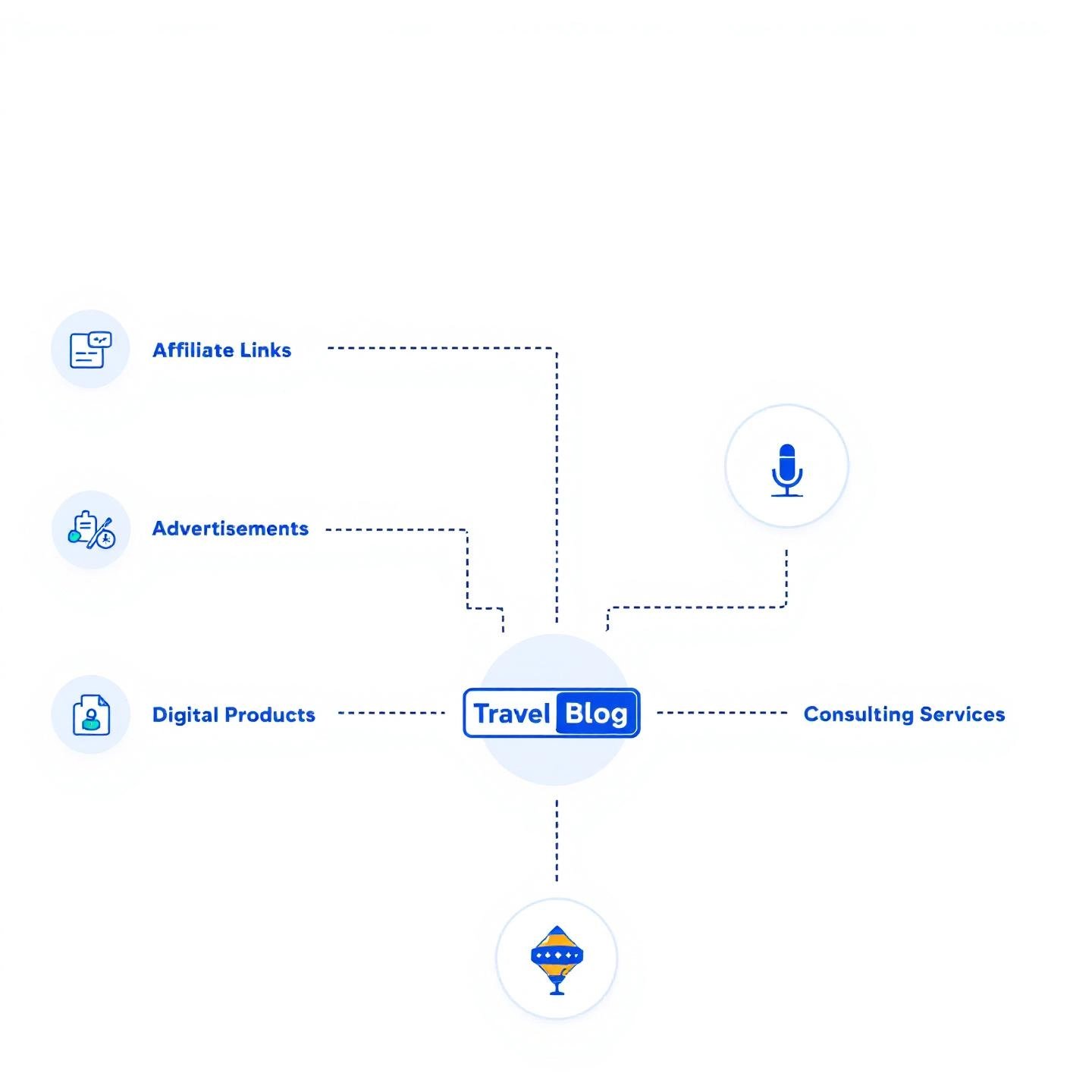Introduction to How to Start a Travel Blog
Have you ever wondered what it would be like to share your adventures with the world—and actually build something meaningful from your journeys? For many, the dream of travel blogging is about more than collecting passport stamps or snapping Instagram-worthy photos. It’s about crafting stories, building a community, and yes, creating a business that supports your lifestyle. But where do you start? How to start a travel blog? The answer isn’t as daunting as it seems, especially when you approach it with the right mindset and a clear plan.
Imagine taking your passion for travel and transforming it into a thriving digital platform. Today’s travel bloggers are storytellers, digital entrepreneurs, and brand builders. They don’t just document trips—they design experiences, grow audiences, and unlock income streams by following a strategic path. If you’re ready to treat your blog as more than a hobby, you’ll need more than just wanderlust. You’ll need a travel blog business plan and a roadmap tailored for success.
In this comprehensive guide, you’ll find expert-level insights and practical steps to help you navigate every stage of your journey. Whether you’re a complete beginner or looking to turn your casual blog into a business, this blueprint will show you what it takes to stand out in the crowded world of travel blogging.
- Niche Selection: Discover how to find your unique angle and target audience.
- Technical Setup: Get step-by-step guidance on choosing a domain, hosting, and essential tools.
- Content Creation: Learn strategies for writing engaging stories that attract and retain readers.
- Monetization: Explore proven ways to generate income from your travel blog.
- Growth Strategies: Uncover tactics to build an audience and scale your blog over time.
Ready to chart your own course? Let’s dive in and turn your travel dreams into a business reality—one strategic step at a time.

What Is a Travel Blog and Why Start One Now
When you hear the phrase "travel blog," what springs to mind? Maybe it’s a digital diary filled with personal stories and snapshots from the road. But today’s travel blogs have evolved far beyond online journals. So, what is a travel blog in the modern sense, and why start one now?
The Evolution of Travel Blogging: From Diary to Digital Platform
In the early days, travel blogs were simple, personal chronicles—think dial-up internet, pixelated photos, and raw, unfiltered storytelling. These early bloggers shared their journeys for the love of adventure and connection, building small communities around authentic experiences. Over time, however, the landscape changed dramatically. Now, a successful travel blog is a dynamic platform that blends storytelling, practical advice, stunning visuals, and even business strategy. It’s a place where personal anecdotes meet actionable guides, and where readers can find inspiration, resources, and community all in one spot (source).
How to start a travel blog? Understanding this evolution is key. Today, your blog can serve multiple purposes: it can be a portfolio for your photography, a resource hub for niche travel tips, a vehicle for building a brand, and even a launchpad for digital products or services. The lines between creator, entrepreneur, and community leader have blurred, opening up new possibilities for anyone willing to embrace the challenge.
Why Start a Travel Blog Now? The Opportunity Is Bigger Than Ever
Wondering if it’s too late to join the travel blogging world? Here’s why now is an ideal time to dive in:
- Global Travel Is on the Rise: More people than ever are exploring the world, seeking unique experiences and turning to blogs for trusted advice and fresh inspiration (source).
- Advanced Digital Tools: Modern platforms like WordPress.org, social media integration, and easy-to-use design tools make launching and growing a blog more accessible than ever before.
- Monetization Opportunities: From affiliate marketing to sponsored content and digital products, travel blogs now offer diverse ways to earn income, even for new creators.
- Demand for Authenticity: Readers crave real stories and honest recommendations—something personal blogs can deliver better than generic travel sites or AI-generated content.
- SEO and Social Media Leverage: With strategic content planning, it’s possible to reach new audiences quickly through search engines and platforms like Instagram, Pinterest, and TikTok.
Imagine starting a blog today and, within a year, seeing your guides help thousands of readers plan their own adventures—or even landing your first sponsored partnership. The digital landscape rewards those who are willing to share authentic, helpful content and adapt to new trends. If you’re passionate about travel and eager to build something meaningful, there’s never been a better moment to get started.
In the next section, we’ll explore how you can carve out your own unique space in this vibrant, ever-expanding world of travel blogging.
Finding Your Unique Angle in a Crowded Market
When you picture the world of travel blogging, it’s easy to feel overwhelmed. With countless voices sharing stories from every corner of the globe, how can you stand out? The secret isn’t just about traveling more or writing better—it’s about finding your unique angle. In other words, the answer to "How to start a travel blog?" often begins with choosing a specific niche that resonates both with you and a targeted audience.
Why Niche Selection Matters
Sounds complex? Here’s why it’s so important: If you try to appeal to everyone, your message can get lost in the noise. But when you focus on a particular group or interest, you’ll find it easier to attract loyal readers and monetize your blog. Think about it—would you rather be one of a thousand general travel blogs, or the go-to resource for solo female hiking in South America or luxury vegan retreats in Europe?
How to Identify Your Travel Blog Niche
- Start with Self-Assessment: What are your passions, skills, and travel experiences? Your genuine enthusiasm and expertise will shine through and attract like-minded readers.
- Research the Market: Look for gaps or underserved topics. Use keyword tools and browse other blogs to spot what’s missing or where you can offer a fresh perspective.
- Define Your Audience: Who are you writing for? Consider their age, interests, travel style, and budget. The more specific, the better.
- Balance Passion and Profit: While it’s tempting to follow your heart, check if your niche has monetization potential—think affiliate products, tours, or digital guides.
- Analyze the Competition: Study leading blogs in your space. What are they doing well? Where can you offer something different or more in-depth?
- Test and Refine: Don’t be afraid to tweak your focus as you learn what resonates with your audience and what keeps you excited to write.
Broad Topics vs. Niche Opportunities: A Side-by-Side Look
| Blog Topic | Target Audience | Monetization Ideas |
|---|---|---|
| General Travel | All travelers, broad age range | Ads, general affiliate links, sponsored posts |
| Solo Female Adventure Travel | Women 20-40, adventure seekers | Gear reviews, female-focused tours, safety guides |
| Eco-Friendly Family Vacations | Eco-conscious families with children | Eco-lodge affiliates, family gear, destination guides |
| Luxury Vegan Retreats | Affluent, health-focused travelers | Retreat bookings, vegan product affiliates, e-books |
| Budget Backpacking in Southeast Asia | Young adults, budget travelers | Hostel affiliates, travel insurance, backpacking gear |
Examples of Unique Travel Blog Topics
- Traveling with pets in Europe
- Accessible travel for wheelchair users
- Historical walking tours for culture lovers
- Digital nomad life in emerging destinations
- Wellness retreats and mindfulness travel
You’ll notice that the most successful travel blogs don’t try to cover everything—they dig deep into a specific area and become trusted resources. By choosing a focused niche, you not only make it easier for readers to find you but also set yourself up for more meaningful partnerships and monetization opportunities.
Ready to define your own space? In the next section, you’ll learn how to turn your niche idea into a professional blog with the right technical setup—no coding experience required.

The Essential Steps to Set Up Your Travel Blog
When you picture launching your own travel blog, the technical side might seem overwhelming. Where do you even start? What if you’re not a tech expert? The good news: setting up a professional-looking travel blog has never been more accessible—with the right roadmap, you can go from idea to launch without coding skills or a huge budget. Here’s your step-by-step travel blog setup checklist to help you build a solid foundation and avoid common pitfalls.
1. Choose and Register Your Domain Name
Imagine your domain name as your blog’s home address. It should be short, memorable, and relevant to your niche. For example, if your focus is eco-friendly family travel, pick something that reflects that identity. Use a reputable domain registrar like NameCheap, Domain.com, or SiteGround to check availability and secure your chosen name.
2. Select Reliable Web Hosting
Your web host stores your website’s files and makes them accessible online. Prioritize speed, uptime, security, and customer support over rock-bottom prices. Well-known providers like SiteGround, Bluehost, or DreamHost offer beginner-friendly plans perfect for WordPress blogs. Many hosts also bundle free domain registration for the first year, but consider keeping domain and hosting separate for greater flexibility and security.
3. Install WordPress
WordPress is the most popular content management system for bloggers—and for good reason. It’s free, flexible, and supported by a huge ecosystem of themes and plugins. Most hosting companies offer one-click WordPress installation, making this step quick and painless. Once installed, you’ll access your dashboard at yourblog.com/wp-admin to begin customizing.
4. Pick and Customize a Theme
Your theme controls the look and feel of your travel blog. Start with a clean, responsive theme like Astra, which is free and highly customizable. You can use page builder plugins (like Elementor or Spectra) for extra design flexibility. Don’t get stuck on colors and fonts at the start—focus on clarity and readability. You can always refine your design as your brand evolves.
5. Create Essential Pages
Set up these foundational pages before you start publishing blog posts:
- About: Share your story and what readers can expect.
- Contact: Make it easy for brands and readers to reach you.
- Privacy Policy: Required for legal compliance, especially if you collect emails or use ads.
- 404 Page: A custom error page improves user experience if someone lands on a broken link.
6. Install Essential Plugins
Plugins add features to your blog without the need for coding. Here’s a basic plugin checklist for how to create a travel blog that’s secure, fast, and optimized:
- SEO: Yoast SEO helps you optimize posts for search engines.
- Image Optimization: Smush compresses images for faster loading.
- Security: Wordfence protects against malware and hackers.
- Backups: UpdraftPlus schedules automatic site backups.
- Social Sharing: Social Snap adds share buttons to grow your audience.
- Analytics: MonsterInsights connects Google Analytics for visitor insights.
- Interactive Maps & Galleries: Travelers’ Map and 10Web’s Photo Gallery enrich your visual storytelling.
Be selective with plugins—too many can slow down your site. Focus on essentials and add new tools as your needs grow.
7. Connect Google Analytics and Search Console
These free tools from Google help you track traffic, understand your audience, and monitor your performance in search results. Follow the official setup guides to connect your blog and start collecting data. Remember, it may take a few days for stats to appear, especially if your site is brand new (reference).
8. Launch and Start Publishing
Once your setup is complete, it’s time to write your first posts and share your unique perspective with the world. Don’t stress about perfection—focus on value and authenticity. As you grow, you’ll refine your design, content, and strategy.
So, how to start a travel blog? By following this checklist, you’ll have a professional, secure, and reader-friendly foundation that sets you up for long-term success. Next, we’ll dive into the art of writing compelling travel stories that keep readers coming back for more.
How to Write Compelling Travel Stories That Engage Readers
Ever scrolled through a travel blog and felt like you were reading a checklist of places, rather than being swept away on the journey? That’s the difference between a simple trip report and engaging storytelling. If you’re wondering how to write a travel blog post that truly connects, it’s all about transforming your experiences into stories that spark curiosity, emotion, and inspiration. So, how to start a travel blog? It begins with mastering the art of storytelling—an essential skill for anyone hoping to stand out in today’s crowded digital landscape.
From Trip Report to Story: What Makes Readers Care?
Sounds complex? Not really. Imagine you visit a bustling market in Marrakech. A basic trip report might list what you ate and which stalls you visited. But a compelling story draws readers in: the aroma of spices, the clatter of bargaining voices, the flash of a vendor’s bright scarf. Great travel writing lets your audience experience the journey alongside you, not just read about it.
Actionable Travel Blog Writing Tips
- Show, Don’t Just Tell: Instead of saying, “The sunset was beautiful,” describe the colors streaking across the sky or the way the air cooled as the sun dipped below the horizon. Use sensory details—what you saw, heard, smelled, and felt—to transport readers to the scene.
- Use First-Person Perspective for Authenticity: Writing in the first person (“I wandered through the alleyways…”) creates intimacy and helps readers connect with your unique voice. Don’t be afraid to share your emotions, challenges, or surprises along the way (source).
- Structure for Readability: Attention spans are short. Break up your content with headings, bullet points, and short paragraphs (3-5 sentences max). Use subheadings to guide readers through your post and make it easy to scan.
- Make It a Resource, Not Just a Diary: While personal stories are powerful, frame your posts to answer readers’ questions or solve their problems. For example, instead of “My Weekend in Glacier National Park,” try “A Budget Guide to Glacier National Park (With My Top Tips).” Weave your personal experience into actionable advice.
- Use High-Quality Visuals: Photos are as important as words. Include original, well-edited images to complement your narrative. Even smartphone photos can be powerful when thoughtfully composed and edited. Visuals help break up text and provide another layer of storytelling.
- Write with SEO in Mind: Identify keywords your readers are searching for (like “travel blog writing tips” or “how to write a travel blog post”) and integrate them naturally into your headings and body text. But remember—Google’s Helpful Content update rewards authentic, valuable writing over keyword stuffing. Focus on answering real questions and providing genuine value.
- Edit Ruthlessly: Don’t be afraid to cut unnecessary details or repetitive phrases. Aim for clarity, flow, and impact in every paragraph.
Storytelling Techniques That Make a Difference
- Answer the 5Ws: Who, what, when, where, and why—these basics help ground your story and provide context.
- Build a Narrative Arc: Start with a hook, build tension or curiosity, and finish with a satisfying resolution or takeaway.
- Include Dialogue and Local Voices: Quotes or snippets from locals or fellow travelers add personality and authenticity.
- Vary Tone and Pacing: Match your writing style to the mood—slow and reflective for a tranquil beach, fast and energetic for a bustling city.
When to Seek Help: Professional Content Services
Feeling stuck or overwhelmed by the writing process? You’re not alone. Many successful travel bloggers turn to professional content writing services to help with research, editing, or even full blog post creation. Services like BlogSpark offer AI-powered tools and expert guidance to streamline content creation, maintain consistency, and ensure your stories are both engaging and optimized for search engines. Whether you’re aiming for rapid growth or just want to free up more time for travel, leveraging these resources can be a smart move—especially as you scale your blog.
Mastering the craft of storytelling is what transforms a travel blog from a personal diary into a resource readers return to again and again. Next, let’s explore the business side: are travel blogs still profitable, and what does it take to turn your passion into income?
Are Travel Blogs Still Profitable?
When you picture the glamorous lifestyle of a travel blogger, it’s easy to assume it’s all about free trips and passive income. But are travel blogs profitable in today’s crowded digital world? The short answer is yes—travel blogs can still be lucrative, but the path to a sustainable travel blogger salary looks different than it did a decade ago. Let’s break down the realities and expectations so you can approach your journey with the right mindset.
Dispelling the Myths: It’s Not a Get-Rich-Quick Scheme
Sounds tempting, right? Imagine hitting publish and watching the money roll in. The reality is, most travel bloggers spend months—sometimes years—building their brand and audience before seeing significant income. Early on, expect modest earnings: many new bloggers make $500–$1,000 per month by the end of their first year, primarily from affiliate links and ads. As your traffic and influence grow, so does your income potential, but it takes persistence and a willingness to learn new skills.
What Does a Successful Travel Blogger Salary Look Like?
Let’s look at some real-world examples. Top travel bloggers like Johnny Ward, Matt Kepnes, and Kiersten Rich have built businesses earning six or even seven figures annually, thanks to multiple income streams—think affiliate marketing, digital products, sponsored content, and more. But these success stories didn’t happen overnight. They invested years into creating helpful content, building audiences, and diversifying revenue sources.
- Year 1: $500–$1,000 per month (mostly from affiliates and ads)
- Years 2–3: $3,000–$5,000 per month (adding sponsored posts, brand deals)
- Year 4 and beyond: $10,000+ per month (with digital products, courses, and expanded partnerships)
Of course, these numbers vary—some bloggers support comfortable lifestyles, travel the world, or even buy homes with their blog earnings (reference). Others treat their blog as a side hustle or creative outlet with smaller, but still meaningful, rewards.
What Makes a Travel Blog Profitable?
- Consistency: Regular, high-quality content builds trust and drives traffic.
- Niche Focus: Specialized blogs attract loyal readers and targeted partnerships.
- Diversified Income: Combining ads, affiliates, products, and services maximizes earning potential.
- Audience Engagement: Building a real community leads to more opportunities and higher conversions.
If you’re wondering, “How to start a travel blog?”—know that profitability comes from treating your blog as a business, not a hobby. The most successful travel bloggers are strategic, patient, and always learning. In the next section, you’ll discover the main ways travel blogs make money and how to plan your own monetization roadmap.

How Do Travel Blogs Make Money?
After understanding the income potential of travel blogging, it’s natural to ask: how do travel blogs make money, and what monetization methods actually work? If you’re picturing a mix of ad revenue, brand partnerships, and digital products—you’re on the right track. The best part? You don’t have to choose just one. Successful travel bloggers often combine several income streams, building a more stable and scalable business over time. Let’s break down the most popular travel blog monetization methods and how they fit into your roadmap.
1. Affiliate Marketing: Earning Through Recommendations
Imagine sharing your favorite travel gear, booking sites, or insurance providers—and earning a commission when readers make a purchase through your links. That’s the core of affiliate marketing. For travel bloggers, this often means:
- Promoting products like backpacks, cameras, or travel accessories
- Recommending travel booking platforms (hotels, tours, flights)
- Writing destination guides with links to relevant services
With affiliate marketing, you can start earning even with a small but engaged audience. Many top bloggers report that affiliate revenue is one of their largest and most reliable income sources.
2. Display Advertising: Monetizing Blog Traffic
Display ads are another foundational income stream. Once your blog attracts steady traffic, you can join ad networks like Google AdSense, Mediavine, or AdThrive. These networks place relevant ads on your site, and you get paid based on impressions (views) and clicks. The more visitors you have, the higher your ad earnings. For example, some established travel blogs earn thousands per month from display ads alone.
- Simple to set up—just add a code snippet to your blog
- Passive income that grows with your audience
- Best suited for blogs with moderate to high traffic
3. Sponsored Content and Brand Partnerships
As your blog grows in influence, brands, tourism boards, and travel companies may offer to pay for sponsored posts, product reviews, or social media campaigns. Sponsored content allows you to:
- Earn money by featuring destinations, products, or experiences
- Negotiate flat fees, free trips, or product exchanges
- Build long-term relationships with brands in your niche
Transparency is key—always disclose sponsored posts to maintain trust with your audience.
4. Digital and Physical Product Sales
Think beyond ads and affiliates—many travel bloggers create and sell their own products, such as:
- Travel guides and ebooks
- Printable itineraries or packing lists
- Photography presets and online courses
- Branded merchandise (tote bags, t-shirts, travel gear)
Product sales provide direct income and let you showcase your expertise, creativity, or unique travel style.
5. Services: Consulting, Tours, and Workshops
If you have specialized knowledge or local expertise, consider offering:
- Travel consulting or itinerary planning
- Online workshops (photography, blogging, travel hacking)
- Guided tours or small group travel experiences
These services can command premium rates and help you build a loyal community around your blog.
6. Additional Revenue Streams
- Email advertisements to your newsletter subscribers
- Freelance writing for other travel publications
- Monetizing video content on YouTube or social media
- Crowdfunding or Patreon memberships for exclusive content
How to start a travel blog? It’s about more than just writing—it’s about strategically layering these monetization methods as your audience and authority grow. In the next section, you’ll learn how to craft your initial monetization strategy and set realistic goals for your own travel blogging journey.
Crafting Your Initial Monetization Strategy
When you’re just starting out, the idea of making money from your travel blog can feel both exciting and overwhelming. Where do you even begin? The truth is, building a profitable blog isn’t about throwing every monetization method at the wall and hoping something sticks. It’s about having a clear, phased travel blog monetization strategy that grows alongside your audience and expertise. So, how to monetize a travel blog from day one—and why is it so important to plan ahead?
Why You Need a Monetization Plan from the Start
Imagine pouring hours into your content, only to realize months later that you’ve missed key opportunities to earn. Many new bloggers focus solely on writing, hoping income will follow naturally. But as seasoned creators point out, consistent content alone rarely leads to sustainable profits (reference). Instead, you need a profit plan—one that’s mapped out early, with milestones and action steps to guide your growth.
Sounds complex? Not really. Think of it like planning a trip: you set your destination (your income goal), then chart a course with stops along the way (key monetization milestones). By working backward from your big goal, you’ll identify what to focus on each month, making your journey more intentional and less overwhelming.
The Value of a Phased Monetization Approach
Trying to do everything at once—ads, affiliates, products, sponsorships—can lead to burnout and scattered results. Instead, adopt a phased approach. Start with foundational strategies that require little traffic, then layer on more advanced methods as your blog and community grow. This way, you build confidence, avoid overwhelm, and set yourself up for long-term success.
| Phase | Focus | Key Actions | Monetization Methods |
|---|---|---|---|
| 1. Foundation | Build authority, grow audience | SEO, content creation, list building | Affiliate links, basic ad networks |
| 2. Growth | Increase traffic, deepen engagement | Expand email list, optimize old posts, collaborate | Advanced affiliates, targeted sponsored posts |
| 3. Expansion | Diversify income streams | Develop digital products, host webinars, launch services | Product sales, consulting, premium content |
| 4. Scale | Automate and optimize | Create evergreen funnels, join premium ad networks | Passive income from ads, recurring affiliate programs |
Practical Steps to Monetize Your Travel Blog Early
- Set Clear Goals: Define your income target (e.g., $1,000/month) and break it into achievable milestones.
- Choose Traffic-Independent Methods First: Affiliate marketing and basic ad networks can start earning with even modest traffic.
- Map Out Content with Profit in Mind: Plan posts around buyer-intent keywords or product reviews that align with your audience’s needs.
- Build Your Email List: Start collecting emails from day one to nurture relationships and promote offers directly.
- Test and Refine: Track what works, adjust your strategy, and add new monetization streams as you grow.
How to start a travel blog? It’s about more than just writing—it’s about thinking like a business owner from the outset. By crafting a phased, intentional monetization plan, you’ll avoid common pitfalls and set, sustainable income. next, discover how the engine that powers your blog’s growth revenue potential.

Building an Audience to Grow Your Income
Imagine pouring your heart into travel stories, only to see them go unnoticed. Sound familiar? For every aspiring blogger, building an audience is the engine that drives both influence and income. In fact, the size and loyalty of your readership often determine how much you can earn—whether through ads, affiliate links, or brand partnerships. So, how to start a travel blog that not only inspires but also attracts a steady stream of visitors? It all comes down to having a smart, multi-faceted traffic plan.
Why Audience Growth Matters
Your audience is your greatest asset. Each new reader is a potential subscriber, customer, or advocate for your brand. The bigger and more engaged your audience, the more opportunities you have to monetize—whether you’re aiming for side income or a full-time travel blogger lifestyle. But with search engines and social platforms constantly evolving, you need more than luck to stand out.
Key Traffic Strategies for Travel Blogs
- SEO (Search Engine Optimization): SEO remains the backbone of blog traffic—even in a world of changing algorithms. Focus on creating original, valuable content around targeted keywords. Internal linking is crucial: connect related posts so readers (and search engines) see your site as an authoritative resource. Regularly update and refresh old posts to keep rankings strong, and always optimize images and meta descriptions for search visibility.
- Pinterest: Think of Pinterest as a visual search engine, not just a social platform. Beautiful, well-designed pins can drive thousands of visitors to your blog—especially for travel inspiration and guides. Create pins for each post, use keyword-rich descriptions, and share your best travel photography. Pinterest loves evergreen, year-round content, so focus on guides and resources that aren’t tied to one season.
- Email List Building: Social media trends come and go, but your email list is yours to own. Offer valuable freebies (like packing lists or destination guides) to encourage sign-ups. Then, nurture your subscribers with regular updates, exclusive tips, and personal stories. An engaged email list is not only a direct traffic source but also a powerful tool for promoting products and affiliate offers.
- Social Media: Platforms like Instagram, Facebook, and TikTok are great for building brand awareness and connecting with your audience in real time. But instead of posting just for likes, use social media to drive traffic back to your blog. Share snippets, behind-the-scenes content, and interactive stories that tease your latest posts. Engage with travel communities and groups to expand your reach—just remember, the goal is to bring followers to your website, where you control the experience.
Pro Tips to Grow Your Travel Blog Audience
- Consistency is key: Stick to a regular posting schedule so readers know when to expect new content.
- Focus on value: Answer real questions, solve problems, and inspire your readers to take action.
- Network with other bloggers: Collaborate, guest post, and share each other’s content to reach new audiences.
- Participate in online communities: Join travel forums, Facebook groups, and niche communities where your target readers hang out.
- Track your analytics: Use Google Analytics and Search Console to see what’s working—and double down on your most popular topics.
Growing your travel blog audience isn’t about chasing viral moments. It’s about building trust, delivering consistent value, and using proven travel blog traffic strategies to bring readers back again and again. As your audience grows, so does your income potential—and your influence as a travel expert. Next, you’ll discover how to wrap up your blogging journey with a clear roadmap for ongoing success.
Conclusion
When you look back at everything we’ve covered, you’ll notice that starting a successful travel blog isn’t about luck or having the fanciest camera—it’s about following a systematic process and staying true to your unique voice. Sounds complex? Not at all. Imagine you’re planning a big trip: you wouldn’t just buy a ticket and hope for the best. You’d pick your destination (niche), pack your essentials (technical setup), plan your itinerary (content strategy), budget for the journey (monetization), and map out how you’ll get from one place to the next (growth tactics). The same approach applies to building a standout travel blog.
The Five Pillars of a Successful Travel Blog
- Niche Selection: Define what sets you apart and who you’re writing for. The more specific your focus, the easier it is to attract loyal readers and monetize effectively.
- Technical Setup: Choose a memorable domain, reliable hosting, and a user-friendly platform like WordPress. Invest in essential plugins and design tools to create a seamless reader experience.
- Content Creation: Develop engaging stories, helpful guides, and stunning visuals. Use travel blog content creation tools to streamline your workflow and maintain consistency.
- Monetization: Start with simple strategies like affiliate marketing and ads, then layer on sponsored content, products, or services as your audience grows.
- Growth: Build your audience through SEO, Pinterest, email lists, and social media. Track analytics to refine your strategy and keep readers coming back.
How to start a travel blog? It’s about taking each step with intention—knowing that every piece of the process builds on the last. There’s no single “right” way, but there is a proven path: focus on value, authenticity, and continuous learning. Your passion, paired with a clear roadmap, is what will set you apart in a crowded digital world.
Final Encouragement and a Smart Next Step
Feeling inspired but not sure where to begin, or maybe stuck on content planning or SEO? You’re not alone. Many bloggers find the technical or creative side overwhelming at first. That’s where travel blog content creation tools can make all the difference. For those seeking a real edge, consider exploring BlogSpark—an expert partner that helps streamline your content strategy, automate tedious writing tasks, and ensure your blog is both engaging and optimized for growth. Whether you’re aiming to publish more consistently or simply want to focus on telling better stories, leveraging the right tools can free up your time for what matters most: sharing your adventures with the world.
Remember, every successful travel blog started with a single post and a willingness to learn. Start today, stay flexible, and enjoy the journey—because your story is just getting started.
Frequently Asked Questions About Starting a Travel Blog
1. Is a travel blog worth it in 2025?
Starting a travel blog in 2025 is worthwhile if you aim to develop skills in writing, SEO, or digital entrepreneurship, or if you want to share authentic travel experiences. While financial success takes time and effort, blogging can be rewarding for those dedicated to building a brand and community. Focusing on a specific niche and treating your blog as a business increases your chances of turning your passion into meaningful income.
2. Do travel bloggers really travel for free?
Most travel bloggers do not start out traveling for free. Brands and tourism boards may eventually offer free trips or sponsorships to bloggers with a strong audience and proven value. To reach this stage, you need to consistently produce high-quality content, grow your following, and demonstrate how you can benefit potential partners. Free travel is often the result of strategic business development, not just a perk of having a blog.
3. What are the essential steps to start a travel blog?
To start a travel blog, begin by selecting a memorable domain name and reliable hosting, then install WordPress for easy content management. Choose a clean, responsive theme, create essential pages like About and Contact, and install core plugins for SEO, security, and analytics. Once your site is set up, focus on writing engaging stories and building your audience through SEO and social media strategies.
4. How do travel blogs make money?
Travel blogs generate income through multiple streams: affiliate marketing, display ads, sponsored content, digital or physical product sales, and service offerings like consulting or workshops. Diversifying revenue sources and planning monetization from the start are key to building a profitable travel blog. As your audience grows, so do your opportunities for higher earnings and brand partnerships.
5. Can AI tools like BlogSpark help with travel blog content creation?
AI-powered tools such as BlogSpark can greatly simplify content creation for travel bloggers. They assist with keyword research, SEO-optimized outlines, and drafting engaging posts, allowing you to publish more consistently and focus on storytelling. BlogSpark also helps maintain a cohesive brand voice and streamlines workflow, making it easier for both beginners and established bloggers to scale their content and reach.




